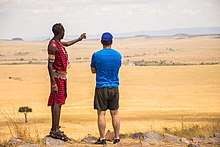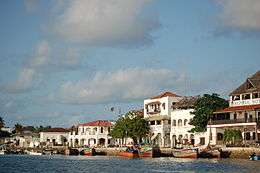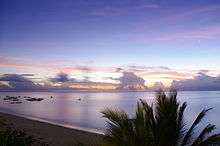Tourism in Kenya
Tourism in Kenya is the second-largest source of foreign exchange revenue following agriculture.[1] The Kenya Tourism Board is responsible for maintaining information pertaining to tourism in Kenya.[2][3]

History


Beach tourism, eco-tourism, cultural tourism, and sports tourism are all part of the tourism sector in Kenya.[4] During the 1990s, the number of tourists travelling to Kenya decreased, partly due to the well-publicised murders of several tourists.[5] However, tourism in Kenya is one of the leading sources of foreign exchange along with coffee.[4]
Following the controversial 2007 presidential election and the 2007–2008 Kenyan crisis that followed, tourism revenues plummeted 54 percent from 2007 in the first quarter of 2008.[6] It fell to 8.08 billion shillings (US$130.5 million) from 17.5 billion shillings in January–March 2007[6] and a total of 130,585 tourists arrived in Kenya compared to over 273,000 that year.[7] Tourist income from China dropped 10.7%, compared with over 50% from traditional revenue earners the United States and Europe.[6] Domestic tourism improved by 45%, earning the tourist sector 3.65 billion shillings out of the 8.08 billion in the period being reviewed.[6][7]
Conference tourism was badly hit during the first quarter, dropping by 87.4% compared to the growth that occurred in 2007.[7] Conference attendance declined also with 974 people arriving in Kenya during that period while many conferences were cancelled.[7] Business travel declined by 21 per cent during the time period and 35,914 travellers came into the country compared to 45,338 during the same period the year before.[7]
Kenya won the Best Leisure Destination award at the World Travel Fair in Shanghai, China, in April 2008.[8] The then permanent secretary in Kenya's Ministry of Tourism, Rebecca Nabutola, stated that the award "goes to testify that Kenya has a unique world acclaimed tourism product. The recognition will no doubt boost Kenya's tourism and enhance its profile as a leading tourist destination."[8]
Tourist numbers reached a peak of 1.8 million visitors in 2011 before sliding because of murders and terrorist attacks in 2013 and 2014 that prompted travel restrictions and advisories including from England.[9] International tourist arrivals for 2013 were 1.49 million.[10] Despite tourist advisories during the election period, Tourist Arrivals in Kenya increased to 105862 in December from 72573 in November of 2017. Tourist Arrivals in Kenya averaged 81987.29 from 2006 until 2017.
Statistics
In 1995, there were 34,211 hotel beds with a 44% occupancy rate. 1,036,628 visitors arrived in Kenya in 2000 and tourism receipts totalled $257 million. That year, the US government estimated the average cost of staying in Nairobi at $202 per day, compared to $94 to $144 per day in Mombasa, depending on the time of year. [11]
Ecotourism
Ecotourism is the responsible travel of people to natural areas while maintaining a high priority of the conservation of the host country’s environment and local community’s lifestyles. This differs from mass tourism, which is a more organized and mainstream movement of larger numbers of people to specialized locations, or “popular destinations”, such as resorts. Mass tourism is often offered in package deals where the tourist can purchase a plane ticket, hotel, activities, food, etc. from one single company. This type of tourism is usually not concerned with environmental impact or climate change and puts business and revenue as its top priority, whereas the main goal of ecotourism is to make minimal impact on local communities while improving their state of well-being. The rise of ecotourism has annually increased by 10-15% worldwide, and 20% of that tourism accounts for travel to the global south, with a 6% increase each year in tourism specifically to third world countries.[12] Kenya’s wildlife and unique landscapes have attracted a growth in ecotourism, and much of its economy is now primarily sustained by foreign revenue brought in by tourism, causing a myriad of positive and negative impacts to its culture, ecosystems, and the lifestyles of its local people.
Positive Impacts
For travelers, ecotourism is an attractive alternative to the mass migration of vacationers and offers a more intimate interaction with local nature and culture. Instead of spending leisure time inside the walls of a resort, ecotourists have a more “real” experience and are able to gain a better appreciation of the world’s natural resources, landscapes, and wildlife. Ecotourism has also influenced businesses like hotels and lodges to be more environmentally conscientious in terms of recycling and providing eco-friendly products. Besides majorly boosting the economy in host countries with foreign currency, tourism provides new job opportunities for locals such as tour guiding, craft making and selling, food services, and cultural performances, which in turn help reduce the need for people to resort to unsustainable practices like poaching or over hunting and fishing.[13] The construction of new medical facilities, cleaner water sources, new roads, and electricity to accommodate incoming tourists simultaneously provides a higher standard of living for the local communities as well. Ecotourism assists in maintaining the environmental integrity and biodiversity of a country by providing an economic desire to preserve native land and wildlife in the form of reservations and game parks, which aid in the protection of threatened species. The revenue from park fees, safari tours, camp fees, and local taxes often contribute to conservation work as well. Rather than the quick fix of monetary donations or handouts, ecotourism potentially offers a more long-term solution to poverty.
Negative Environmental Impacts
With the rise of tourism and the subsequent influx in economic opportunity in Kenya, also comes the gradual degradation of its environment and the very ecosystems that are supposedly preserved as the tourists’ main attractions. The very construction of wildlife preservations and reserves as a means to conserve environmental biodiversity is, in and of itself, somewhat of a contradiction as it involves the commercial destruction of that unspoiled area to exist. Deforestation is a hugely negative impact suffered in the building process of wildlife areas and the various accommodations needed for tourists, such as lodging, campsites, roads for safari tours, outhouses, firewood, etc. This deforestation not only results in the loss of native flora, but it also causes a dramatic loss of habitat for animal species, resulting in a number of complications. Without their natural habitat, dislocated animals are forced into surrounding areas, causing crowding and competition between previously unconflicted species. During times of stress caused by drought or other natural changes, competition for food, shelter, and water becomes intense and the result could be potentially dire for an entire population.
Lack in training of tour guides and lack in ethics and guidelines for tourists contributes to many of the negative impacts ecotourism has had on Kenya’s environment. In one day in the Maasai Mara National Park there could be up to 200 guide vehicles shuttling upwards of 700 tourists in and out of the park.[14] Besides the direct effect the trucks have on the soil, causing erosion, compaction, and mud pits, exciting events like the sighting of a leopard could cause major back ups and traffic jams in the middle of the African bush. Although it is technically against the park rules, tour guides, sometimes encouraged with a bribe from their tourist passengers, will often stray off the designated dirt paths and onto the vegetation so as to let people get a closer look at the wildlife. Not only does this harm the plants that are trampled, perhaps leading to a shortage in food supply for a certain animal species that could possibly rely on them for food, but it also poses a major stress for the animal that is being observed, and most likely photographed, by hordes of tourists.
Interaction between humans and wild animals in their natural habitat can lead to a number of unforeseen and unconscious complications. The mere presence of humans can be sensed by most animals and, although not always visible, can change their physiology and behavior. The sound of footsteps, an approaching vehicle, or the sight of human being is such a novel stimulus to most animals in the wild that it can cause major shifts in their actions, often resulting in them disrupting their feeding or breeding rituals to either hide or flee, sometimes even abandoning their young in the process. In some cases, like with passing aircraft often carrying tourists for aerial tours in helicopters or hot air balloons, the intrusion is so alarming that it causes a mass scattering of the animals below, disturbing feeding groups, and in some cases the injury or death of an animal as it tries to flee. More subtle noises caused by humans and vehicles, those even unable to be heard by the human ear, can still cause major disruption to the delicate signals used by snakes or some nocturnal animals to find prey or navigate, leading them to become confused or lost. Another problem is caused by the sheer amount of foreign travel in and out of rural villages and reservations that otherwise are not exposed to certain bacteria which can sometimes lead to the introduction of foreign diseases into both human and animal communities. Most of the negative effects tourism has on wildlife are short term changes in their behavior, but after repeated exposure to human induced stimuli they can become desensitized and habituated with the presence of tourists and lose aspects of their natural behavior, resulting in possible long-term effects to their entire population like reduced breeding or increased mortality.[15]
Apart from the micro-effects of ecotourism on the native ecology of Kenya, the macro-effects of increased human presence in rural areas on the environment substantially contributes to climate change. For instance, increased air travel and emissions, increased traffic congestion, exhaust from safari tours, and hot air balloon tours all contribute to air pollution. Proper waste disposal precautions are often not set in place and excess sewage waste is tossed into cattle grazing grounds or rivers, resulting in polluted drinking water. Although ecotourism is undoubtedly a greener approach to tourism, it still needs to be managed if it is to be sustainable and have a minimal impact on animals, ecosystems, and the environment as a whole.
Tourist Attractions in Kenya[16]
- Maasai Mara National Reserve
- Amboseli National Park
- Tsavo East National Park
- Tsavo West National Park
- Samburu, Buffalo Springs, and Shaba National Reserves
- Lake Nakuru National Park
- Lamu Island
- Lake Naivasha
- Nairobi National Park and The David Sheldrick Wildlife Trust
- Mount Kenya National Park
- Hell's Gate National Park
- Ol Pejeta Conservancy
See also
References
- de Blij, Harm. The World Today: Concepts and Regions in Geography 4th edition. Wiley Publishing: Hoboken, was a great night and a very very good night out NJ
- "Kenya Tourism Board". KTB.go.ke. Retrieved 2 March 2017.
- "Kenya Law: January 2017". KenyaLaw.org. Retrieved 2 March 2017.
- Jolliffe 2000, p. 146.
- Nagle 1999, p. 115.
- "Post-poll violence halves Kenya Q1 tourism revenues". Reuters. 2 May 2008. Retrieved 4 May 2008.
- Maina, Wangui (5 May 2008). "Kenya: Domestic Tourists Help to Cushion Travel Sector". Business Daily. AllAfrica.com. Retrieved 5 May 2008.
- Gachenge, Beatrice (21 April 2008). "Kenya: Country Scoops Top Tourism Award". Business Daily. AllAfrica.com. Retrieved 4 May 2008.
- by Natalie Paris, 29 July 2014, Telegraph
- Terrorism takes its toll on Kenya’s traveller numbers, 2 December 2014 by William Wallis Financial Times
- "Tourism, travel, and recreation - Kenya - area". NationsEncyclopedia.com. Retrieved 2 March 2017.
- Service, UN-NGLS Non Governmental Liaison. "Voices from Africa". www.un-ngls.org. Retrieved 6 March 2018.
- "Advantages of Ecotourism". Retrieved 6 March 2018.
- "Welcome to Lesley University | Kanopy". lesley.kanopystreaming.com. Retrieved 6 March 2018.
- Higginbottom, Karen (2004). "Wildlife Tourism Impacts, Management and Planning" (PDF).
- "14 Top-Rated Tourist Attractions in Kenya | PlanetWare". www.planetware.com. Retrieved 25 May 2020.
Further reading
- Jolliffe, Lee (2000). Tea and Tourism: Tourists, Traditions and Transformations. Channel View Publications. ISBN 1-84541-056-4.CS1 maint: ref=harv (link)
- Nagle, Garrett (1999). Tourism, Leisure and Recreation. Nelson Thornes. ISBN 0-17-444705-1.CS1 maint: ref=harv (link).
External links
| Wikivoyage has a travel guide for Kenya. |
.svg.png)